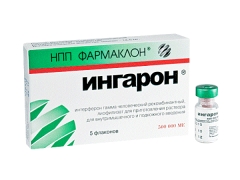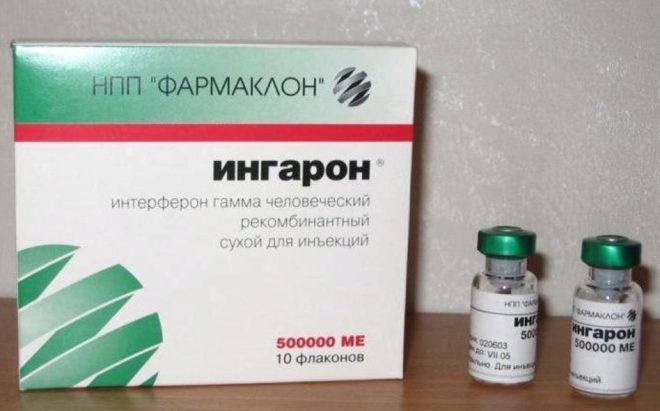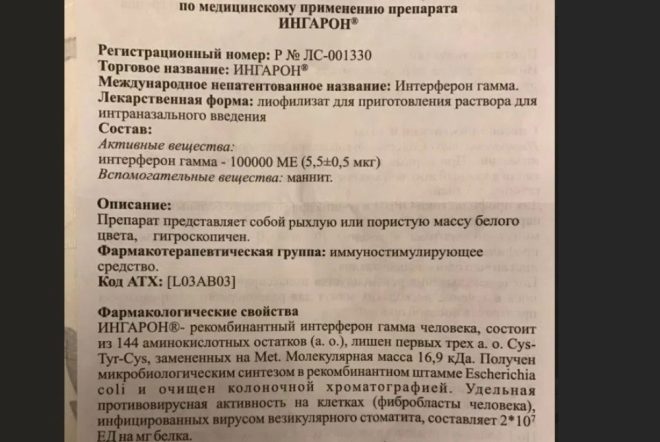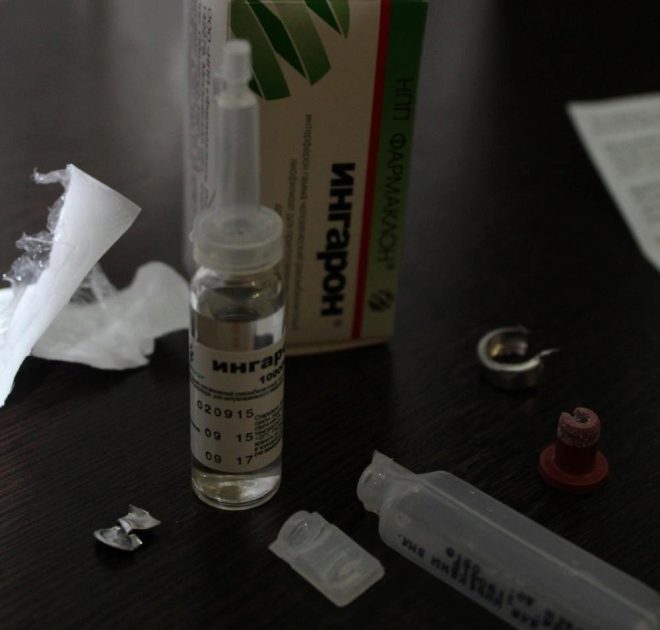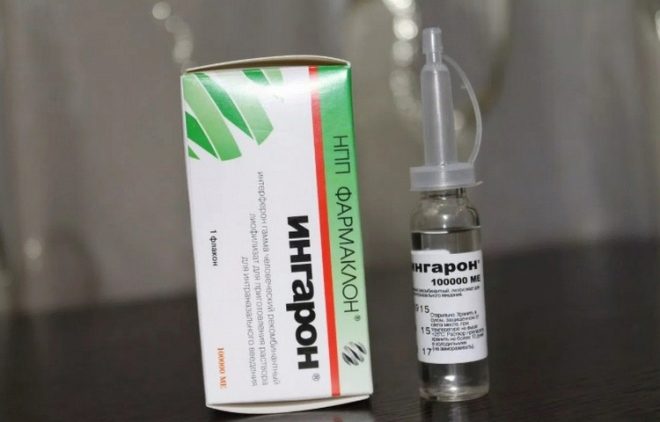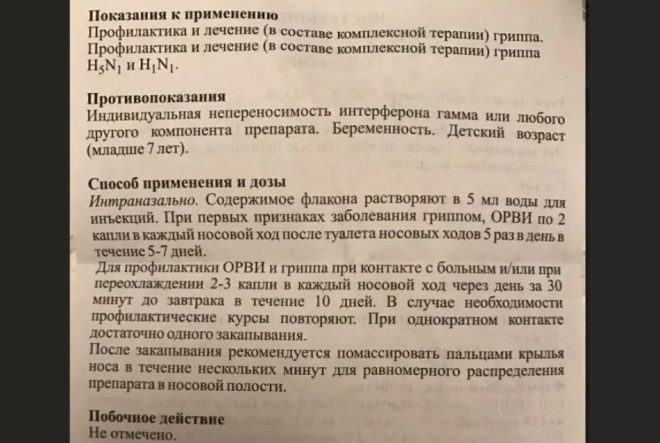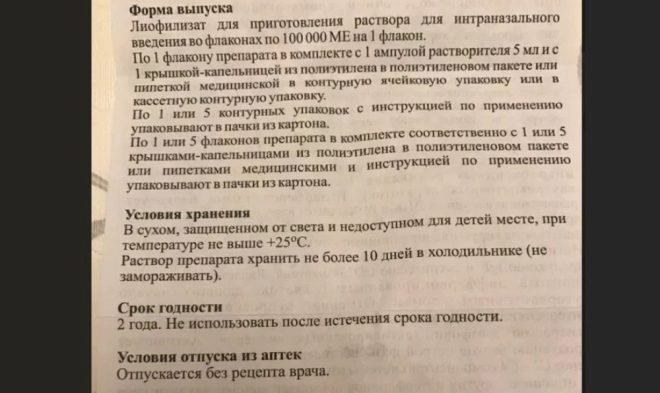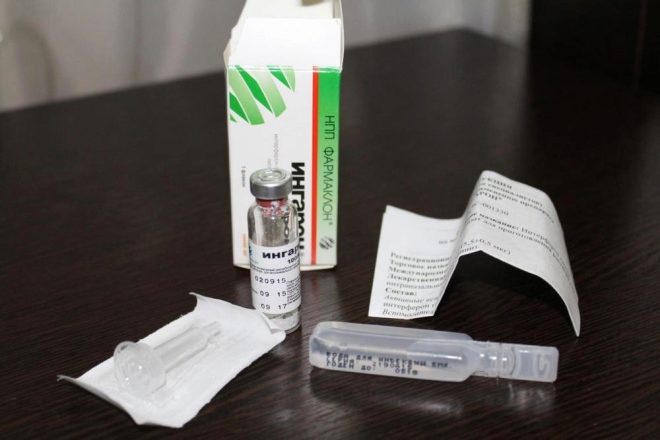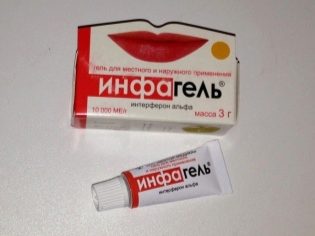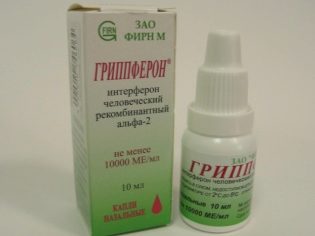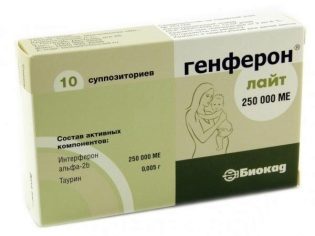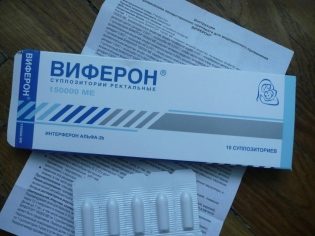Ingaron for children: instructions for use
During the season of viral infections, mothers are especially actively interested in drugs that can stimulate the immune system. One of these means is Ingaron. Is it permitted to children when prescribed and how properly used in childhood?
Release form
Ingaron is produced in glass bottles, inside of which there is a lyophilisate. It is represented by a white hygroscopic mass, which may be porous or loose. One pack of medicine is a cardboard box, inside which is 1 or 5 blister packs. Each such package includes a vial with a lyophilisate and a vial with a solvent, as well as a medical pipette or dropper cap.
The drug is also produced in injectable form, differing only in greater concentration of the active component. One pack can contain from 1 to 20 bottles of medicine.
Composition
The effect of the drug Ingaron is provided by human interferon of the "gamma" type. In one bottle for use in the nose contains 100000 MU of such a substance. Ingaron injectable form contains interferon in a dose of 100 thousand IU, 500 thousand IU, as well as 1 million IU or 2 million IU. The only auxiliary component of the drug is mannitol. In the enclosed ampoule is 5 ml of water for injection.
Operating principle
Ingaron refers to immunostimulating drugs, since gamma interferon in its composition has such an effect on the immune system:
- Activates the function of immune cells (neutrophils, natural killer cells, macrophages, T-lymphocytes with a cytotoxic effect), binding to their receptors. As a result, they more actively produce cytokines and other substances that have antiviral and anti-inflammatory effects.
- It blocks the formation of RNA or DNA of viral cells, as well as the synthesis of proteins of viruses, due to which replication of viral particles is disrupted.
- It has a toxic effect on virus-infected cells.
- Inhibits the response of B cells to interleukin 4, and also reduces the production of immunoglobulin E.
- It activates the destruction of those B-cells that provoke the development of autoimmune reactions.
- It supports the production of proteins involved in suppressing the inflammatory response, and also affects the complement system.
- It prevents the formation of substances that provoke fibrotic changes in the liver or lungs.
Indications
Most often, Ingaron is administered intranasally to children for the treatment of influenza, especially when infected with dangerous strains such as H1N1 or H5N1. In addition, the tool can be used for the prevention of this viral infection, as well as in the treatment of other acute respiratory viral infections.
Ingaron injections are prescribed for viral hepatitis, tuberculosis, shingles, oncopathology, HIV infection, genital herpes, chlamydia and other diseases.
At what age is it allowed to take?
According to the instructions, the use of Ingaron for children under 7 years old is not recommended. If a child is younger, in his treatment or prophylactically, it is better to use other immunostimulating drugs that will suit him in age. This is due to the lack of clinical trials of the lyophilisate and the peculiarities of the immune system in childhood (while it is only being formed, any immune drugs are undesirable).
Contraindications
In addition to the age limit, there is only one more contraindication for Ingaron used in the nose - the drug is not given for its individual intolerance. Adults do not use the medicine while carrying a child, and the injection form should not be used for diabetes and autoimmune pathologies.
Side effects and overdose
The cases of the side effects of the drug on the patient’s body or Ingaron overdose in the form of nasal drops are not known. Injections can cause soreness or redness at the injection site. If very high doses are used, the patient may experience weakness, fever, pain in the head and joints.
Instructions for use and dosage
The drug is used intranasally. Before you begin treatment, you need to properly prepare the solution.
To do this:
- Gently pry a plastic bottle cap with your finger, without tearing it out completely.
- Moving in a circle, remove this cap with a metal cap.
- After removing the rubber cap and opening the vial with sterile water, add it to the vial.
- Place a dropper cap on the vial and shake the solution.
- Drip the child's nose and place the drug in the refrigerator until the next use.
Starting the use of Ingaron is advised at the first symptoms of flu. After clearing the nasal passages of a small patient from crusts or secretions, 2 drops of solution are injected into each nostril of the child. Bury means should be 5 times a day, and the duration of treatment is usually 5-7 days. As soon as the medicament has got into the nasal cavity, it is necessary to massage the wings of the nose for a few minutes so that the solution is distributed evenly over the mucous membrane.
Prophylactic Ingaron is used after contact with the patient or after hypothermia. The course of prophylactic administration lasts 10 days and involves the instillation of medication every other day in each nostril with 2 or 3 drops. If the child has communicated with the sick flu, then prevention can be done only once, by dropping the drug only once after such contact.
Sometimes doctors prescribe inhalation with Ingaron. For one procedure using a nebulizer use one bottle of medication and 2 ml of water for injection.
Ingaron injections are made under the skin or intramuscularly after dilution of the bottle 2 ml of water for injection. The dosage is determined in each case individually, and the duration of treatment can be up to 3 months.
Interaction with other drugs
Ingaron is allowed to combine with any other medicines prescribed for acute respiratory viral infections or flu, for example, with antipyretic drugs.
Terms of sale and storage
To purchase Ingaron intranasal form in a pharmacy, it is not necessary to get a prescription from a doctor; however, when used in children, a doctor's consultation is desirable. Injectable form of the drug refers to the means that sell prescription. The average price of a pack with one bottle of lyophilisate is 260-290 rubles.
Shelf life of the drug is 2 years. While it has not expired, it is possible to keep sealed contour packages of Ingaron for insertion into the nose at room temperature (not higher than +25 degrees) in a dark place where a small child cannot reach.
After dilution of the lyophilisate, the medicine should be placed in a refrigerator, but it should not be frozen. The storage time of the solution is up to ten days. The injection form of the medicine should always be kept in the refrigerator.
Reviews
On the use of Ingaron in children for the prevention of viral diseases or treatment of influenza speak mostly well. Moms confirm that the admission course helped the child not to get sick during the cold season or to have the flu without complications. The disadvantages of the drug include age restrictions, small shelf life and high price. Also, in some children, treatment with Ingaron did not bring the expected improvement.
Analogs
Replace Ingaron can other drugs, which include interferon.They have a similar effect on the child’s body, although they do not include gamma, but alpha interferons.
Instead of a lyophilisate, the doctor may recommend:
- Infagel. Such medicine in the form of a gel can be used for SARS prevention or flu in children of any age. To do this, the drug lubricate the mucous membrane of the nasal passages during the week. Effective medicine and infection with herpes, for example, with chickenpox eruptions or herpes vesicles on the lip.
- Grippferon. This medicine, available in drops and spray, is often prescribed for viral lesions of the respiratory system. He is allowed to drip even to babies.
- Genferon Light. The composition of this medication includes a combination of interferon and taurine. The drug is produced in drops and suppositories, which are allowed at any age.
- Viferon. This drug interferon is used in children with chickenpox, ARVI, candidiasis and other diseases. In the shape of gel and rectal suppositories he is allowed from birth as well ointment use in kids older than a year.
A few words from Dr. Komarovsky about immunomodulators in the next video.
